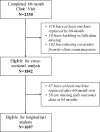Symptoms of Knee Instability as Risk Factors for Recurrent Falls
- PMID: 26853236
- PMCID: PMC4958545
- DOI: 10.1002/acr.22811
Symptoms of Knee Instability as Risk Factors for Recurrent Falls
Abstract
Objective: Whether knee instability contributes to the increased risk of falls and fractures observed in persons with knee osteoarthritis (OA) has not been studied. We examined the association of knee buckling with the risk of falling and fall-related consequences in older adults with, or at high risk for, knee OA.
Methods: At the 60-month visit of the Multicenter Osteoarthritis Study, men and women ages 55-84 years were asked about knee buckling in the past 3 months and whether they fell when a knee buckled. Falls and fall-related injuries in the past 12 months and balance confidence were assessed at 60 and 84 months. Multivariate logistic regression was used to assess the association of knee buckling with falls and their consequences.
Results: A total of 1,842 subjects (59% women, mean ± SD age 66.9 ± 7.8 years, and body mass index 30.3 ± 5.7) were included. At 60 months 16.8% reported buckling and at 84 months 14.1% had recurrent (≥2) falls. Bucklers at 60 months had a 1.6- to 2.5-fold greater odds of recurrent falls, fear of falling, and poor balance confidence at 84 months. Those who fell when a knee buckled at baseline had a 4.5-fold, 2-fold, and 3-fold increased odds 2 years later of recurrent falls, significant fall injuries, and fall injuries that limited activity, respectively, and were 4 times more likely to have poor balance confidence.
Conclusion: Interventions that reduce knee buckling may help prevent falls, fall-related injuries, and adverse psychological consequences of falls in persons with knee OA.
© 2016, American College of Rheumatology.
Similar articles
-
The impact of knee instability with and without buckling on balance confidence, fear of falling and physical function: the Multicenter Osteoarthritis Study.Osteoarthritis Cartilage. 2014 Apr;22(4):527-34. doi: 10.1016/j.joca.2014.01.008. Epub 2014 Feb 6. Osteoarthritis Cartilage. 2014. PMID: 24508777 Free PMC article.
-
Falls Associated with Muscle Strength in Patients with Knee Osteoarthritis and Self-reported Knee Instability.J Rheumatol. 2015 Jul;42(7):1218-23. doi: 10.3899/jrheum.140517. Epub 2015 May 1. J Rheumatol. 2015. PMID: 25934818
-
Knee Instability and Basic and Advanced Function Decline in Knee Osteoarthritis.Arthritis Care Res (Hoboken). 2015 Aug;67(8):1095-102. doi: 10.1002/acr.22572. Arthritis Care Res (Hoboken). 2015. PMID: 25732594 Free PMC article.
-
Risk Factors for Falls in Adults with Knee Osteoarthritis: A Systematic Review.PM R. 2019 Jul;11(7):745-757. doi: 10.1002/pmrj.12066. Epub 2019 Mar 28. PM R. 2019. PMID: 30609282
-
[Fall risk and fracture. The association of physical performance with falls in the elderly].Clin Calcium. 2013 May;23(5):713-8. Clin Calcium. 2013. PMID: 23628685 Review. Japanese.
Cited by
-
Analysis of the Associations between Arthritis and Fall Histories in Korean Adults.Int J Environ Res Public Health. 2021 Apr 3;18(7):3758. doi: 10.3390/ijerph18073758. Int J Environ Res Public Health. 2021. PMID: 33916869 Free PMC article.
-
Knee Osteoarthritis and the Risk of Medically Treated Injurious Falls Among Older Adults: A Community-Based US Cohort Study.Arthritis Care Res (Hoboken). 2019 Jul;71(7):865-874. doi: 10.1002/acr.23725. Epub 2019 Jun 13. Arthritis Care Res (Hoboken). 2019. PMID: 30133173 Free PMC article.
-
Musculoskeletal adaptation of young and older adults in response to challenging surface conditions.J Biomech. 2022 Nov;144:111270. doi: 10.1016/j.jbiomech.2022.111270. Epub 2022 Sep 6. J Biomech. 2022. PMID: 36162144 Free PMC article.
-
A Definition of Significant Instability and a Scoring System for Predicting Meniscal Tears in ACL-Deficient Knees.Orthop J Sports Med. 2019 Aug 29;7(8):2325967119866732. doi: 10.1177/2325967119866732. eCollection 2019 Aug. Orthop J Sports Med. 2019. PMID: 31497613 Free PMC article.
-
Knee biomechanics variability before and after total knee arthroplasty: an equality of variance prospective study.Sci Rep. 2024 Feb 1;14(1):2673. doi: 10.1038/s41598-024-52965-w. Sci Rep. 2024. PMID: 38302571 Free PMC article.
References
-
- Fitzgerald GK, Axe MJ, Snyder-Mackler L. The efficacy of perturbation training in nonoperative anterior cruciate ligament rehabilitation programs for physical active individuals. Physical therapy. 2000;80(2):128–40. Epub 2000/02/02. PubMed PMID: 10654060. - PubMed
-
- Felson DT, Niu J, McClennan C, Sack B, Aliabadi P, Hunter DJ, et al. Knee buckling: prevalence, risk factors, and associated limitations in function. Ann Intern Med. 2007;147(8):534–40. Epub 2007/10/17. doi: 147/8/534 [pii]. PubMed PMID: 17938391. - PubMed
-
- Nguyen US, Felson DT, Niu J, White DK, Segal NA, Lewis CE, et al. The impact of knee instability with and without buckling on balance confidence, fear of falling and physical function: the Multicenter Osteoarthritis Study. Osteoarthritis Cartilage. 2014;22(4):527–34. Epub 2014/02/11. doi: 10.1016/j.joca.2014.01.008. PubMed PMID: 24508777; PubMed Central PMCID: PMCPMC4059670. - PMC - PubMed
-
- Skou ST, Wrigley TV, Metcalf BR, Hinman RS, Bennell KL. Association of knee confidence with pain, knee instability, muscle strength, and dynamic varus-valgus joint motion in knee osteoarthritis. Arthritis Care Res (Hoboken) 2014;66(5):695–701. Epub 2013/10/16. doi: 10.1002/acr.22208. PubMed PMID: 24127243. - PubMed
-
- Colbert CJ, Song J, Dunlop D, Chmiel JS, Hayes KW, Cahue S, et al. Knee confidence as it relates to physical function outcome in persons with or at high risk of knee osteoarthritis in the osteoarthritis initiative. Arthritis Rheum. 2012;64(5):1437–46. Epub 2011/12/03. doi: 10.1002/art.33505. PubMed PMID: 22135125; PubMed Central PMCID: PMCPMC3319513. - PMC - PubMed
Publication types
MeSH terms
Grants and funding
LinkOut - more resources
Full Text Sources
Other Literature Sources
Medical
Miscellaneous


